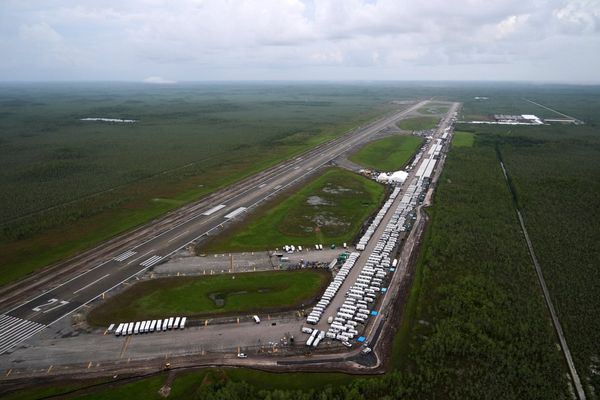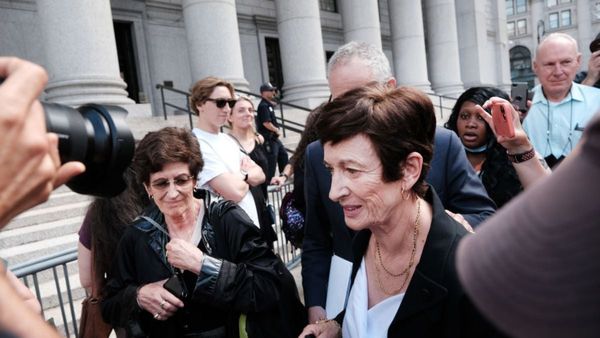
The Midwest is at the center of this year’s races for governor. But some blue-leaning states out West are fast becoming some of the most competitive — and surprising — races of 2022.
Democratic governors swept across the middle of the country in 2018, winning governorships in states like Michigan, Wisconsin and Pennsylvania. And while all the races will be hyper-competitive in November, Democrats have piled up fundraising advantages and polling leads in those states, from Govs. Gretchen Whitmer in Michigan and Tony Evers in Wisconsin to open-seat Pennsylvania candidate Josh Shapiro.
Yet as some of those races have gotten tougher for the GOP, Republicans have grown increasingly bullish on a quartet of gubernatorial elections further west: Defending their open seat in Arizona, challenging incumbent Democrats in New Mexico and Nevada, and — most surprisingly — making a strong charge for the open seat in reliably blue Oregon, where an independent candidate has scrambled the usual electoral math.
Those dynamics — along with the Supreme Court’s Dobbs decision focusing more attention than ever on elections for governor — have seen Republicans get a boost in some places while also buoying Democratic hopes of beating back a wave in some of the key presidential battleground states.
“I think our governors and our candidates are showing resiliency throughout the cycle to the national whims that historically show up in midterm years for the party of the president in power,” said Marshall Cohen, the political director of the Democratic Governors Association.
Still, Democrats remain largely on defense, with the party either trying to protect incumbents or retain control of open seats in most of the tight battlegrounds in the middle of the county.
POLITICO's Election Forecast projects that more Americans will live in a state with a Democratic governor instead of a Republican chief executive after the 2022 elections, even as Republicans are likely to have more governorships in total. But beyond those topline figures, POLITICO projects as many as a dozen competitive races in November — along with two near sure-thing pickups for Democrats in Massachusetts and Maryland.
"Incumbent governors are hard to defeat, and so you need incredibly strong candidates to do that successfully. We feel many of our candidates out West have proven to be the type of rock star recruits that can get the job done,” said Joanna Rodriguez, a spokesperson for the Republican Governors Association.
Republicans believe they have a real opportunity to target New Mexico Gov. Michelle Lujan Grisham, who was recently the chair of the DGA. The party is happy with its recruit, former TV weatherman Mark Ronchetti, and believes the first-term incumbent is vulnerable.
“You look at these states with vulnerable incumbents and it's a result of a combination of three factors — a heavily wrong track environment in the state, incumbents who are incapable of breaking 50 percent on the ballot, and strong challengers,” said Phil Cox, a former RGA executive director who now advises a number of governor campaigns.
“All three of those factors exist in New Mexico,” he continued. “In some of the other competitive states, you have one or two of those factors. But where all three exist, that’s when you have a recipe for beating an incumbent governor.”
Republicans are also watching the state to see if they can energize Latino voters. But Democrats, while conceding that the race is competitive, believe that eager Republicans have overstated how in-play the state is.
Jared Leopold, a one-time spokesperson for the DGA who is now advising Lujan Grisham, said that Ronchetti was a “flawed candidate” who hasn’t proven to voters he could govern — and that the issue of abortion was galvanizing voters in the state to back the incumbent.
“A big focal point in the last couple months has been abortion. He’s dropped in the polls because of that,” Leopold said, adding it was “toxic” for Ronchetti, who cut an ad earlier this summer trying to rebut attacks on the issue.
Nevada has also risen to the top of Republicans’ target list, and it could be one of the nation’s most expensive races, with Democratic Gov. Steve Sisolak raising a boatload of money.
But Republicans believe Sisolak is vulnerable as well, and the nominee there — Clark County Sheriff Joe Lombardo — was one of the party’s prized recruits.
The two open races out West have also tracked significant attention. In Arizona, Trump-backed Kari Lake, a former TV anchor who also spreads election conspiracy theories, defeated the candidate backed by outgoing Gov. Doug Ducey and other more establishment-minded Republicans in the state.
Despite that, Lake is getting significant support from Republicans for her general election matchup with Democratic Secretary of State Katie Hobbs. Ducey, the co-chair of the RGA, endorsed Lake shortly after the primary, and both party committees have already pledged significant resources for the state.
The other open state race, in Oregon, is perhaps the most unusual race in the country. There, the typically blue state was upended by the independent candidacy of a well-funded former Democratic state senator, Betsy Johnson. Now, she, Democrat Tina Kotek and Republican Christine Drazan all have a viable shot at replacing outgoing Democratic Gov. Kate Brown.
The early TV ads have been a merry-go-round of the candidates attacking one another. Johnson’s campaign has swung at both Kotek and Drazan, releasing a recent TV ad saying the two party nominees were “leading the two extremes.” Drazan, meanwhile, pushed out an ad tying Johnson and Kotek to Brown, emphasizing Johnson’s now-former party affiliation. And Kotek has a TV ad attacking Johnson over gun control measures.
Republicans are betting, in part, that Johnson will pull more from would-be Democratic voters than Republicans. Kevin Looper, a top strategist for Johnson, argued that the route to victory in the state runs through the roughly 40 percent of the electorate that isn’t registered with a particular party, which all three candidates are clawing for. The dynamic sets up the possibility that the winner in the state won’t approach majority support.
“I think the next governor of Oregon is for sure going to have under 40 percent of the vote,” Looper said, “and will likely have around 35 percent — maybe as high as 37 percent.”
Dems fight for the Midwest
As the battlefield expands in the West, Democrats have maintained the early leads they built in the Midwestern swing states.
Whitmer has routinely hit the critical 50 percent benchmark in polls, and she also has the largest cash advantage out of any battleground Democratic incumbent. Still, Republican Tudor Dixon — who emerged from one of the most chaotic primaries in recent memory with the support of both Trump and Michigan’s GOP establishment — is getting notable backup, including from an outside group backed by the DeVos family, and many expect the race to tighten and to remain competitive through the fall.
No matter any candidate’s strength, Michigan and other nearby states — including Wisconsin, Minnesota and Pennsylvania — could all remain close in November. The states are simply too closely divided.
That is especially true for Wisconsin, which is shaping up to be the most competitive swing state in the region. Public polling there has had the Trump-endorsed businessman Tim Michels and Evers very close — and Michels had already poured millions of his own money into his campaign during the primary.
Republicans do, however, feel confident about Ohio Gov. Mike DeWine’s reelection effort in a state that has slipped away from Democrats in the region recently.
But Democrats have done what they can to protect their standing elsewhere. Incumbents have stockpiled cash for years, and Shapiro was effectively anointed the party nominee in Pennsylvania before the primary even really began, giving him an edge over Republican Doug Mastriano.
Mastriano, like most other GOP candidates apart from Minnesota’s Scott Jensen, had to battle through contentious primaries while Democrats coasted.
“It has helped that our fundraising has allowed us to communicate to voters earlier than ever before. And the Republican primaries really created opportunities for us,” the DGA’s Cohen said. “I do think our ability to define the Republicans, either them doing it themselves in a primary or us being able to communicate pre-Labor Day, has made a huge difference in a lot of races.”
Mastriano — an extremist candidate who is part of a Trump-aligned group of election deniers running for statewide office across the country — has been a notably poor fundraiser, and he has received scant support from deep-pocketed state or national organizations.
But polling in the Pennsylvania race has been close, and Democrats and Republicans alike expect it to stay that way. Trump has thrown in for Mastriano, rallying for the candidate over the long weekend in one of his first general election appearances — while Democratic candidates in the region cautiously embrace President Joe Biden, with both Evers and Shapiro appearing with him in the last week.
“President Biden has been an important — very important — partner for states across the country to direct recovery funds to our schools, our economy and public safety,” Evers said at a weekend rally, while introducing the president. “He hasn’t forgotten that working families matter.”







